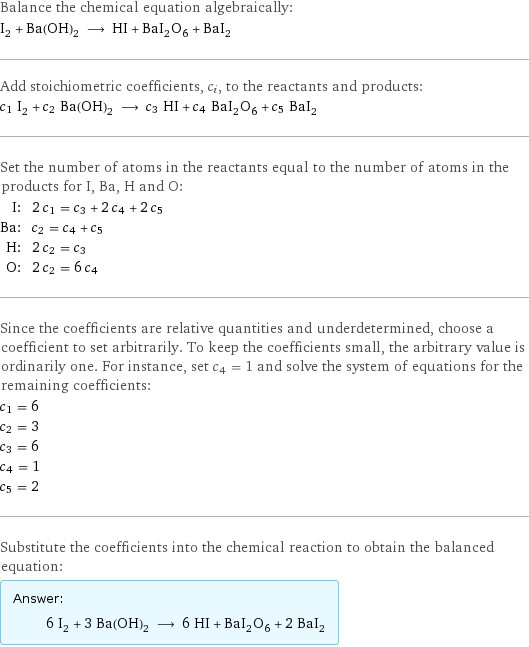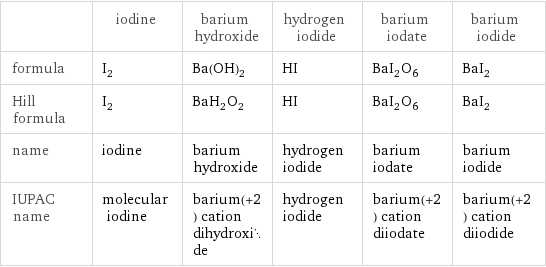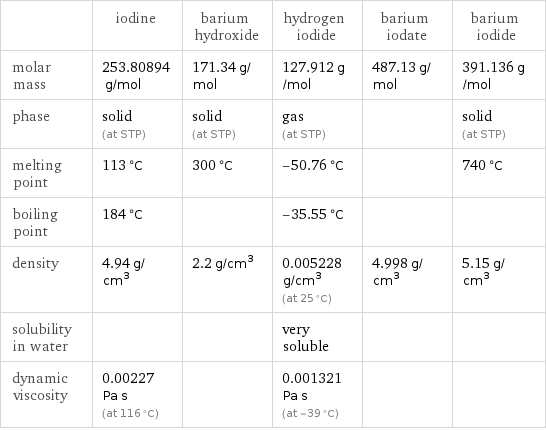Input interpretation

I_2 iodine + Ba(OH)_2 barium hydroxide ⟶ HI hydrogen iodide + BaI_2O_6 barium iodate + BaI_2 barium iodide
Balanced equation

Balance the chemical equation algebraically: I_2 + Ba(OH)_2 ⟶ HI + BaI_2O_6 + BaI_2 Add stoichiometric coefficients, c_i, to the reactants and products: c_1 I_2 + c_2 Ba(OH)_2 ⟶ c_3 HI + c_4 BaI_2O_6 + c_5 BaI_2 Set the number of atoms in the reactants equal to the number of atoms in the products for I, Ba, H and O: I: | 2 c_1 = c_3 + 2 c_4 + 2 c_5 Ba: | c_2 = c_4 + c_5 H: | 2 c_2 = c_3 O: | 2 c_2 = 6 c_4 Since the coefficients are relative quantities and underdetermined, choose a coefficient to set arbitrarily. To keep the coefficients small, the arbitrary value is ordinarily one. For instance, set c_4 = 1 and solve the system of equations for the remaining coefficients: c_1 = 6 c_2 = 3 c_3 = 6 c_4 = 1 c_5 = 2 Substitute the coefficients into the chemical reaction to obtain the balanced equation: Answer: | | 6 I_2 + 3 Ba(OH)_2 ⟶ 6 HI + BaI_2O_6 + 2 BaI_2
Structures

+ ⟶ + +
Names

iodine + barium hydroxide ⟶ hydrogen iodide + barium iodate + barium iodide
Equilibrium constant
![Construct the equilibrium constant, K, expression for: I_2 + Ba(OH)_2 ⟶ HI + BaI_2O_6 + BaI_2 Plan: • Balance the chemical equation. • Determine the stoichiometric numbers. • Assemble the activity expression for each chemical species. • Use the activity expressions to build the equilibrium constant expression. Write the balanced chemical equation: 6 I_2 + 3 Ba(OH)_2 ⟶ 6 HI + BaI_2O_6 + 2 BaI_2 Assign stoichiometric numbers, ν_i, using the stoichiometric coefficients, c_i, from the balanced chemical equation in the following manner: ν_i = -c_i for reactants and ν_i = c_i for products: chemical species | c_i | ν_i I_2 | 6 | -6 Ba(OH)_2 | 3 | -3 HI | 6 | 6 BaI_2O_6 | 1 | 1 BaI_2 | 2 | 2 Assemble the activity expressions accounting for the state of matter and ν_i: chemical species | c_i | ν_i | activity expression I_2 | 6 | -6 | ([I2])^(-6) Ba(OH)_2 | 3 | -3 | ([Ba(OH)2])^(-3) HI | 6 | 6 | ([HI])^6 BaI_2O_6 | 1 | 1 | [BaI2O6] BaI_2 | 2 | 2 | ([BaI2])^2 The equilibrium constant symbol in the concentration basis is: K_c Mulitply the activity expressions to arrive at the K_c expression: Answer: | | K_c = ([I2])^(-6) ([Ba(OH)2])^(-3) ([HI])^6 [BaI2O6] ([BaI2])^2 = (([HI])^6 [BaI2O6] ([BaI2])^2)/(([I2])^6 ([Ba(OH)2])^3)](../image_source/32729574f5107c6ffcb54d65cd3e34f7.png)
Construct the equilibrium constant, K, expression for: I_2 + Ba(OH)_2 ⟶ HI + BaI_2O_6 + BaI_2 Plan: • Balance the chemical equation. • Determine the stoichiometric numbers. • Assemble the activity expression for each chemical species. • Use the activity expressions to build the equilibrium constant expression. Write the balanced chemical equation: 6 I_2 + 3 Ba(OH)_2 ⟶ 6 HI + BaI_2O_6 + 2 BaI_2 Assign stoichiometric numbers, ν_i, using the stoichiometric coefficients, c_i, from the balanced chemical equation in the following manner: ν_i = -c_i for reactants and ν_i = c_i for products: chemical species | c_i | ν_i I_2 | 6 | -6 Ba(OH)_2 | 3 | -3 HI | 6 | 6 BaI_2O_6 | 1 | 1 BaI_2 | 2 | 2 Assemble the activity expressions accounting for the state of matter and ν_i: chemical species | c_i | ν_i | activity expression I_2 | 6 | -6 | ([I2])^(-6) Ba(OH)_2 | 3 | -3 | ([Ba(OH)2])^(-3) HI | 6 | 6 | ([HI])^6 BaI_2O_6 | 1 | 1 | [BaI2O6] BaI_2 | 2 | 2 | ([BaI2])^2 The equilibrium constant symbol in the concentration basis is: K_c Mulitply the activity expressions to arrive at the K_c expression: Answer: | | K_c = ([I2])^(-6) ([Ba(OH)2])^(-3) ([HI])^6 [BaI2O6] ([BaI2])^2 = (([HI])^6 [BaI2O6] ([BaI2])^2)/(([I2])^6 ([Ba(OH)2])^3)
Rate of reaction
![Construct the rate of reaction expression for: I_2 + Ba(OH)_2 ⟶ HI + BaI_2O_6 + BaI_2 Plan: • Balance the chemical equation. • Determine the stoichiometric numbers. • Assemble the rate term for each chemical species. • Write the rate of reaction expression. Write the balanced chemical equation: 6 I_2 + 3 Ba(OH)_2 ⟶ 6 HI + BaI_2O_6 + 2 BaI_2 Assign stoichiometric numbers, ν_i, using the stoichiometric coefficients, c_i, from the balanced chemical equation in the following manner: ν_i = -c_i for reactants and ν_i = c_i for products: chemical species | c_i | ν_i I_2 | 6 | -6 Ba(OH)_2 | 3 | -3 HI | 6 | 6 BaI_2O_6 | 1 | 1 BaI_2 | 2 | 2 The rate term for each chemical species, B_i, is 1/ν_i(Δ[B_i])/(Δt) where [B_i] is the amount concentration and t is time: chemical species | c_i | ν_i | rate term I_2 | 6 | -6 | -1/6 (Δ[I2])/(Δt) Ba(OH)_2 | 3 | -3 | -1/3 (Δ[Ba(OH)2])/(Δt) HI | 6 | 6 | 1/6 (Δ[HI])/(Δt) BaI_2O_6 | 1 | 1 | (Δ[BaI2O6])/(Δt) BaI_2 | 2 | 2 | 1/2 (Δ[BaI2])/(Δt) (for infinitesimal rate of change, replace Δ with d) Set the rate terms equal to each other to arrive at the rate expression: Answer: | | rate = -1/6 (Δ[I2])/(Δt) = -1/3 (Δ[Ba(OH)2])/(Δt) = 1/6 (Δ[HI])/(Δt) = (Δ[BaI2O6])/(Δt) = 1/2 (Δ[BaI2])/(Δt) (assuming constant volume and no accumulation of intermediates or side products)](../image_source/1989007ebadf3f3d8ba7588dca510e96.png)
Construct the rate of reaction expression for: I_2 + Ba(OH)_2 ⟶ HI + BaI_2O_6 + BaI_2 Plan: • Balance the chemical equation. • Determine the stoichiometric numbers. • Assemble the rate term for each chemical species. • Write the rate of reaction expression. Write the balanced chemical equation: 6 I_2 + 3 Ba(OH)_2 ⟶ 6 HI + BaI_2O_6 + 2 BaI_2 Assign stoichiometric numbers, ν_i, using the stoichiometric coefficients, c_i, from the balanced chemical equation in the following manner: ν_i = -c_i for reactants and ν_i = c_i for products: chemical species | c_i | ν_i I_2 | 6 | -6 Ba(OH)_2 | 3 | -3 HI | 6 | 6 BaI_2O_6 | 1 | 1 BaI_2 | 2 | 2 The rate term for each chemical species, B_i, is 1/ν_i(Δ[B_i])/(Δt) where [B_i] is the amount concentration and t is time: chemical species | c_i | ν_i | rate term I_2 | 6 | -6 | -1/6 (Δ[I2])/(Δt) Ba(OH)_2 | 3 | -3 | -1/3 (Δ[Ba(OH)2])/(Δt) HI | 6 | 6 | 1/6 (Δ[HI])/(Δt) BaI_2O_6 | 1 | 1 | (Δ[BaI2O6])/(Δt) BaI_2 | 2 | 2 | 1/2 (Δ[BaI2])/(Δt) (for infinitesimal rate of change, replace Δ with d) Set the rate terms equal to each other to arrive at the rate expression: Answer: | | rate = -1/6 (Δ[I2])/(Δt) = -1/3 (Δ[Ba(OH)2])/(Δt) = 1/6 (Δ[HI])/(Δt) = (Δ[BaI2O6])/(Δt) = 1/2 (Δ[BaI2])/(Δt) (assuming constant volume and no accumulation of intermediates or side products)
Chemical names and formulas

| iodine | barium hydroxide | hydrogen iodide | barium iodate | barium iodide formula | I_2 | Ba(OH)_2 | HI | BaI_2O_6 | BaI_2 Hill formula | I_2 | BaH_2O_2 | HI | BaI_2O_6 | BaI_2 name | iodine | barium hydroxide | hydrogen iodide | barium iodate | barium iodide IUPAC name | molecular iodine | barium(+2) cation dihydroxide | hydrogen iodide | barium(+2) cation diiodate | barium(+2) cation diiodide
Substance properties

| iodine | barium hydroxide | hydrogen iodide | barium iodate | barium iodide molar mass | 253.80894 g/mol | 171.34 g/mol | 127.912 g/mol | 487.13 g/mol | 391.136 g/mol phase | solid (at STP) | solid (at STP) | gas (at STP) | | solid (at STP) melting point | 113 °C | 300 °C | -50.76 °C | | 740 °C boiling point | 184 °C | | -35.55 °C | | density | 4.94 g/cm^3 | 2.2 g/cm^3 | 0.005228 g/cm^3 (at 25 °C) | 4.998 g/cm^3 | 5.15 g/cm^3 solubility in water | | | very soluble | | dynamic viscosity | 0.00227 Pa s (at 116 °C) | | 0.001321 Pa s (at -39 °C) | |
Units
